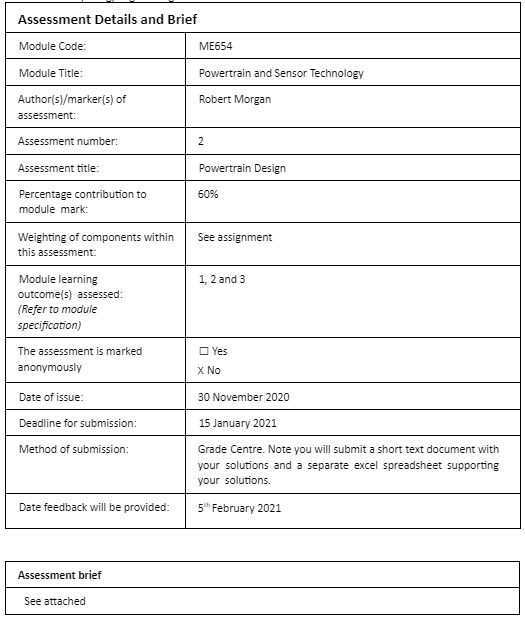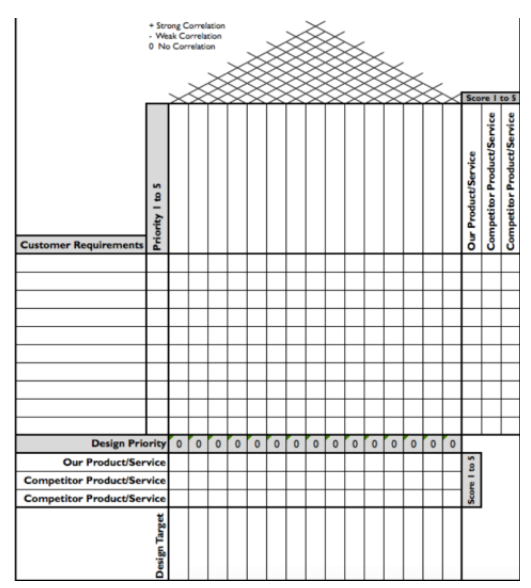Powertrain Variants and Performance Considerations
- 7 Pages
- Published On: 28-11-2023
Assessment marking criteria/rubric
Marks will be awarded for each question as shown on the assignment brief. As a guide, the marks are distributed as follows:
- Numerical accuracy of your answers to the numerical parts of questions (20%) - Approach to solving the problems – have you used an appropriate method and applied the method correctly. This will be evidenced by your Microsoft excel spreadsheet, any assumptions you make and state and calculations you include in your submission appendix. (40%) - Quality of discussion (40%)
Powertrain Design Assignment
The Automotive manufacturer, Dacia, intend to produce a range of two-seater budget sports cars to compete with the Mazda MX5. Three new powertrain variants are planned, namely; a gasoline engine, a plug-in-hybrid and a fully electric version. It has been decided that the gasoline variant will be a turbocharged, direct-injection engine, however, it has not been decided whether operation will be stochiometric, lean or a combination of the two combustion systems at different operating points. For engineering dissertation help, these decisions are critical as they impact performance, emissions, and overall efficiency of the vehicle. The key performance requirements are as follows:

Vehicle specification
- Vehicle Mass 850kg
- Drag Coefficient (Cd) 0.35
- Frontal Area (A) 1.7m2
Performance requirements
- Accelerate from 0-80km/h in 3.5s.
- Accelerate from 80-120 in 12s.
- Able to accelerate from a speed of 100kph on a 20% gradient.

Emissions requirements
- Euro 6d, which can be approximated to 0.1g/kWh of cycle average NOx at two key points (the key points and weighting factors are included in the attached excel spreadsheet).
- Competitive fuel consumption over an urban and motorway drive cycle (drive cycle data is provided in the attached excel spreadsheet).
Vehicle range criteria
- One urban drive cycle is the minimum driving range required in fully electric mode for the hybrid and electric vehicle variants.
- Four motorway drive cycles is the minimum driving range in electric vehicle mode.
- It is expected that the fuel tank will have sufficient capacity for the petrol and hybrid variants to drive at least 500km.
Cost considerations
- Dacia are positioned as a producer of budget, low frills vehicles. No specific price target has been set but your choices should optimise and justify a minimal cost solution.
Resources
You may use any of the course material covered in lectures or developed in tutorials (including spreadsheets) and third-party material (books, papers, web resources) in your work. Please clearly reference any material that you did not develop yourself. If you modify a piece of 3rd party material, reference the original material and say ‘adapted from’ in the reference so it’s clear where you have modified and added to the reference yourself.
Question 1 (10 marks)
Using the drive cycle data supplied and the requirements data above, build a MS Excel spreadsheet to enable you to calculate the following:
- The minimum powertrain power output for the three performance requirements (0-80km/h in 3.5s. 80-120km/h in 12s and pull away on a 20% gradient from 100kph)
- The minimum energy requirements for the two electric vehicle range requirements (assuming that all the braking energy can be recovered).
Present your results in a table. You should include any calculations (which may be a scan of a legible, handwritten sheet) in an Appendix and submit the MS Excel spreadsheet used to determine the energy requirements for the electric vehicle cases.
Question 2 (5 marks)
Using the House of Quality template attached at the end of this document (or a suitable one of your own), suggest key features and functions and a ranking order for the gasoline powered vehicle variant. You do not need to fill in the top of the diagram (‘correlation of features’). It is acceptable to fill in the template by hand and provide a scanned copy.
Question 3 (35marks)
The gasoline variant is required to achieve Euro6d tailpipe emissions. Two key points have been identified in the attached spreadsheet (KP1 &2). The engine can be run either lean or stochiometric and several aftertreatment options are available; a three-way catalyst, a lean NOx trap or both catalysts operating together. Note the engine does can operate at different air-fuel ratio (AFR) at the two key points. Using this data provided, recommend a strategy that gives the best fuel consumption within the specified emissions limit. You may recommend a combination of catalysts or a single catalyst. In your answer, you should include any graphs you produce showing trade-offs between different options and a discussion as to why you have selected a particular strategy including the pros and cons, such as performance and cost of that strategy. If you use a spreadsheet, you should submit your spreadsheet with your answer.
For your proposed powertrain solution, recommend a powertrain specification (boost pressure, compression ratio, cylinder bore size, number of cylinders and engine speed) that meets the performance requirements derived in part 1, based upon the stated requirements. Provide a brief
discussion to justify your recommendation and include any calculations (which may again be submitted in handwritten form) in an Appendix.
Question 4 (35marks)
For the hybrid powertrain variant, three motors are available listed in the table below. The battery pack costs £100/kWh of storage capacity. The internal combustion engine costs £500+£10/kW.

Evaluate the three motor options and recommend a ‘powertrain – motor – battery’ combination that gives the best trade-off between cost and fuel consumption over the urban drive cycle whilst achieving the range criteria in the specification. You should consider the potential benefit of regenerative braking and include a spreadsheet to show how you have calculated the the energy required to complete the urban drive cycle for the three different motor options. Present a short discussion and a table to summarise the results of your analysis that includes the energy required to drive the cycle and cost of the motor, battery, engine, and the total cost for each motor option. You should include any hand calculations in an Appendix.
Question 5 (15 marks)
The electric vehicle variant will have the capability to fast charge in 30minutes. During fast charging, 0.6kW of heat is dissipated into the battery pack that is removed via a water-glycol cooling circuit using a small, air-cooled radiator. If the battery pack must be kept under 50°C during fast charging and the ambient air temperature is 15°C, specify the heat exchanger, coolant flow and air flow required to cool the battery (assume a 2°C change in temperature across the coolant). The radiator available has an overall heat transfer coefficient of 270 W/m2K and the temperature of the air on the hot side of the radiator should be no more than 35°C. Your answer should include a labelled diagram of the vehicle cooling system for the battery including any ancillary components, list of key assumptions and the calculation used to determine your chosen solution.

Presentation of your work
Your work should be presented as a separate answer to each question as outlined below. You do not need to present your work as a formal report and therefore there is no need for summary, introduction or conclusion sections. The total word count should not exceed 1500 words excluding any Appendices. You may include copies of any supporting calculations in an Appendix which may be a legible, clear scan of hand working. You should also submit any MS Excel spreadsheets you create to answer the questions. Please do this as a single MS Excel workbook using sheets as separate tabs for each question answered. On your word document, please indicate the total number of files and file
names you have submitted at the start of your solution so I can check I have all the files you have submitted.
In summary, you should provide the following:
Question1 – Completed table showing the calculated minimum power outputs and vehicle journey energy requirements.
Question 2 – Completed in House of Quality diagram.
Question 3 – Recommended engine operating strategy with key assumptions and any graphs you produce showing the trade-off between the different options. Recommended powertrain geometry to achieve the required performance, including assumptions and calculations (which may be in an Appendix) along with a short discussion to justify your recommendation.
Take a deeper dive into Potential international market for Ecover with our additional resources.
Question 4 – Summary of your recommended configuration and supporting discussion to justify your choices.
Question 5 – Summary of your recommendation, key assumptions and a diagram explaining the cooling circuit.

- 24/7 Customer Support
- 100% Customer Satisfaction
- No Privacy Violation
- Quick Services
- Subject Experts



